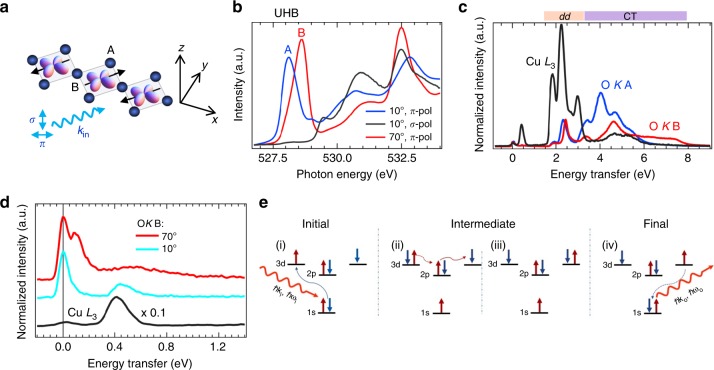Fig. 1.
Summary of the experimental data at the oxygen K-edge. a Cartoon sketch of the Cu-O-Cu corner-shared chains forming the active low-energy degrees of freedom in Sr2CuO3, and of the incident-light geometry. The Cu atoms are primarily in a d9 valence state, where a single hole occupies each of the Cu 3 orbitals and interacts antiferromagnetically with its in-chain neighbours. b The polarization dependence of the XAS spectra. σ-polarized light (black solid line) probes unoccupied states perpendicular to the CuO4-plaquettes, having no spectral weight at the UHB (there are no apical oxygens). Data obtained with π-polarized light at incidence angles of 10° (grazing incidence geometry, blue line) and 70° (close to normal incidence, red line) primarily probes the out-of-chain (A) and in-chain (B) oxygen sites, respectively. The difference in the pre-peak resonance corresponds to the differences in the chemical environments of these two oxygen sites (chemical shifts), where the B site hosts the plaquette-connecting oxygen orbital33. c Polarization dependence for π-polarized O K-edge RIXS data for incident energies tuned to the A (blue) and B (red line) peaks in the XAS shown in b. Incident angles as in b: 70° (10°) corresponds to q ≈ 0 (q ≈ π/2a). The π-polarized Cu L3-edge RIXS data at 20° incidence angle (q ≈ π/2a) is also shown for comparison (black line). The RIXS spectra are normalized to acquisition time. The peaks above 1.8 eV energy transfer are associated to dd (orbiton) and charge transfer (CT) excitations, as indicated. The peak below 0.6 eV in the Cu L3 data corresponds to multi-spinon excitations4. d The Cu L3 and O K B-resonance RIXS data from c and B-resonance for 10° incidence angle (q ≈ π/2a, turquoise line), now focusing on the first 1.3 eV in energy transfer, where several low-energy spin excitations are found. The RIXS data are reported in arbitrary units (a.u.). e Sketch of the double spin-flip process across two Cu sites at the oxygen K-edge

